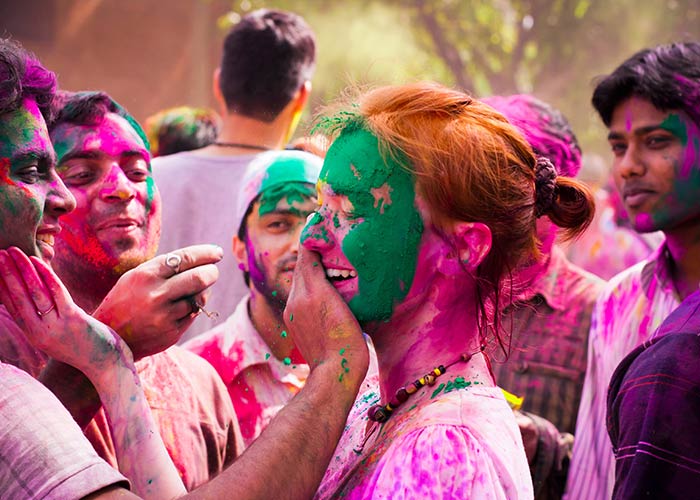Holi
Holi, known as the ‘festival of colors’ is celebrated on the full moon day falling in the month of Phalguna (Feb-Mar). Various colors and water are thrown on each other, amidst loud music, drums etc to celebrate Holi. Like many other festivals in India, Holi also signifies a victory of good over evil. As per ancient mythology, there is a legend of King Hiranyakashipu with who Holi is associated.

History of Holi
Hiranyakashipu was a king in ancient India who was like a demon. He wanted to take revenge for the death of his younger brother who was killed by Lord Vishnu. So to gain power, the king prayed for years. He was finally granted a boon. But with this Hiranyakashipu started considering himself God and asked his people to worship him like God. The cruel king has a young son named Prahalad, who was a great devotee of Lord Vishnu. Prahalad had never obeyed his father’s order and kept on worshiping Lord Vishnu. The King was so hard hearted and decided to kill his own son, because he refused to worship him. He asked his sister ‘Holika’, who was immune to fire, to sit on a pyre of fire with Prahalad in her lap. Their plan was to burn Prahalad. But their plan did not go through as Prahalad who was reciting the name of Lord Vishnu throughout was safe, but Holika got burnt to ashes. The defeat of Holika signifies the burning of all that is bad. After this, Lord Vishnu killed Hiranyakashipu. But it is actually the death of Holika that is associated with Holi. Because of this, in some states of India like Bihar , a pyre in the form of bonfire is lit on the day before Holi day to remember the death of evil.
But how did colors become part of Holi? This dates back to the period of Lord Krishna (reincarnation of Lord Vishnu . It is believed that Lord Krishna used to celebrate holi with colors and hence popularized the same. He used to play holi with his friends at Vrindavan and Gokul. They used to play pranks all across the village and thus made this a community event. That is why till date Holi celebrations at Vrindavan are unmatched.
Holi is a spring festival to say goodbye to winters. In some parts the celebrations are also associated with spring harvest. Farmers after seeing their stores being refilled with new crops celebrate Holi as a part of their happiness. Because of this, Holi is also known as ‘Vasant Mahotsava’ and ‘Kama Mahotsava’.
Holi is an ancient festival
Holi is one of the oldest Hindu festivals and it had probably started several centuries before the birth of Christ. Based of this is, Holi is mention in ancient religious books like, Jaimini’s Purvamimamsa-Sutras and Kathaka-Grhya-Sutra.
Even the temples of ancient India have sculptures of Holi on walls. One of this is a temple from the 16th century in Hampi, the capital of Vijayanagar. The temple has many scenes from Holi sculpted on its walls showing princes and princesses along with their maids holding pichkaris to squirt water on royals.
Many medieval paintings such as a 16th century Ahmednagar painting, Mewar painting (circa 1755), Bundi miniature all depicts Holi celebrations in one way or the other.
Holi colors
Earlier, Holi colors used to be made from flowers of ‘tesu’ or ‘palash’ tree and known as gulal. The colors used to be very good for skin as no chemicals were used to make these. But amidst of all definitions of festivals, the definition of colors for sure have changed with time. Today people have started using harsh colors made from chemicals. Even fast colors are used to play Holi, which are bad and that is why many people avoid celebrating this festival. We should enjoy this age old festival with the true spirit of festivity.
Holi celebrations
Also, Holi is not a one day festival as celebrated in most of the states in India, but it is celebrated for three days.
Day 1 – On full moon day (Holi Purnima) colored powder and water are arranged in small brass pots on a thali. The celebration begins with the eldest male member who sprinkles color on the members of his family.
Day 2- This is also known as ‘Puno’. On this day Holika’s images are burnt and people even light bonfires to remember the story of Holika and Prahalad. Mothers with their babies take five rounds of the bon- fire in a clockwise direction to seek the blessing of the God of fire.
Day 3- This day is known as ‘Parva’ and this is the last and final day of Holi celebrations. On this day colored powder and water is poured on each other.The deities of Radha and Krishna are worshipped and smeared with colors.



Comments
Post a Comment